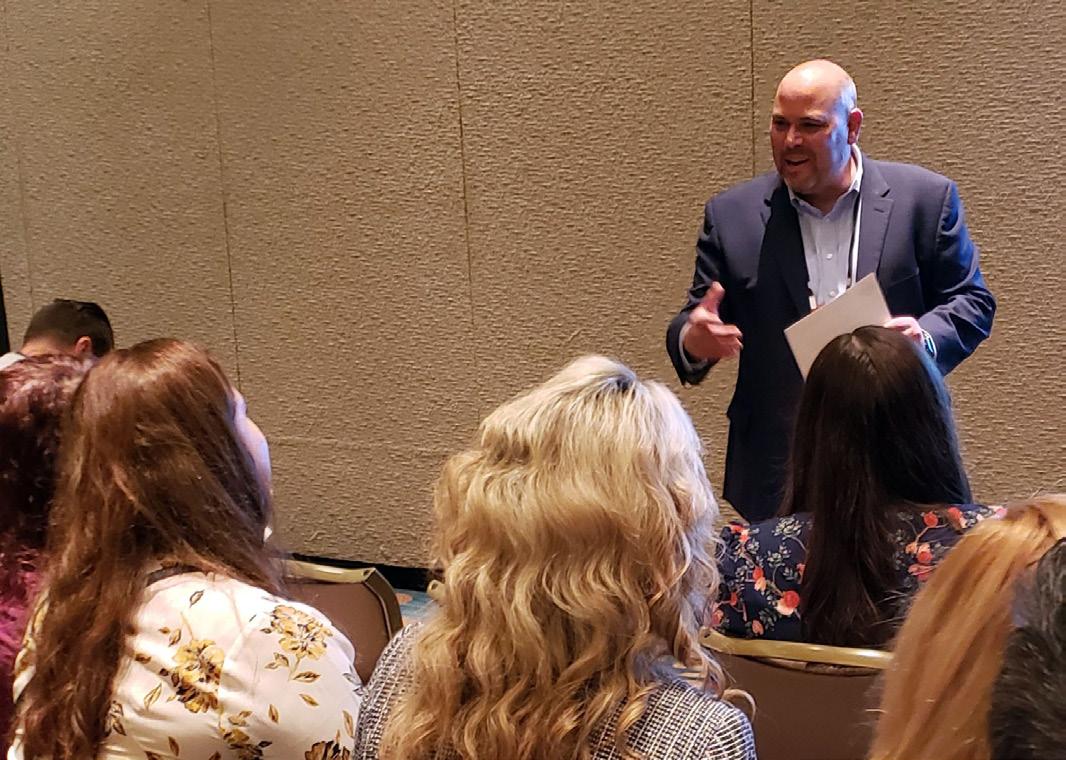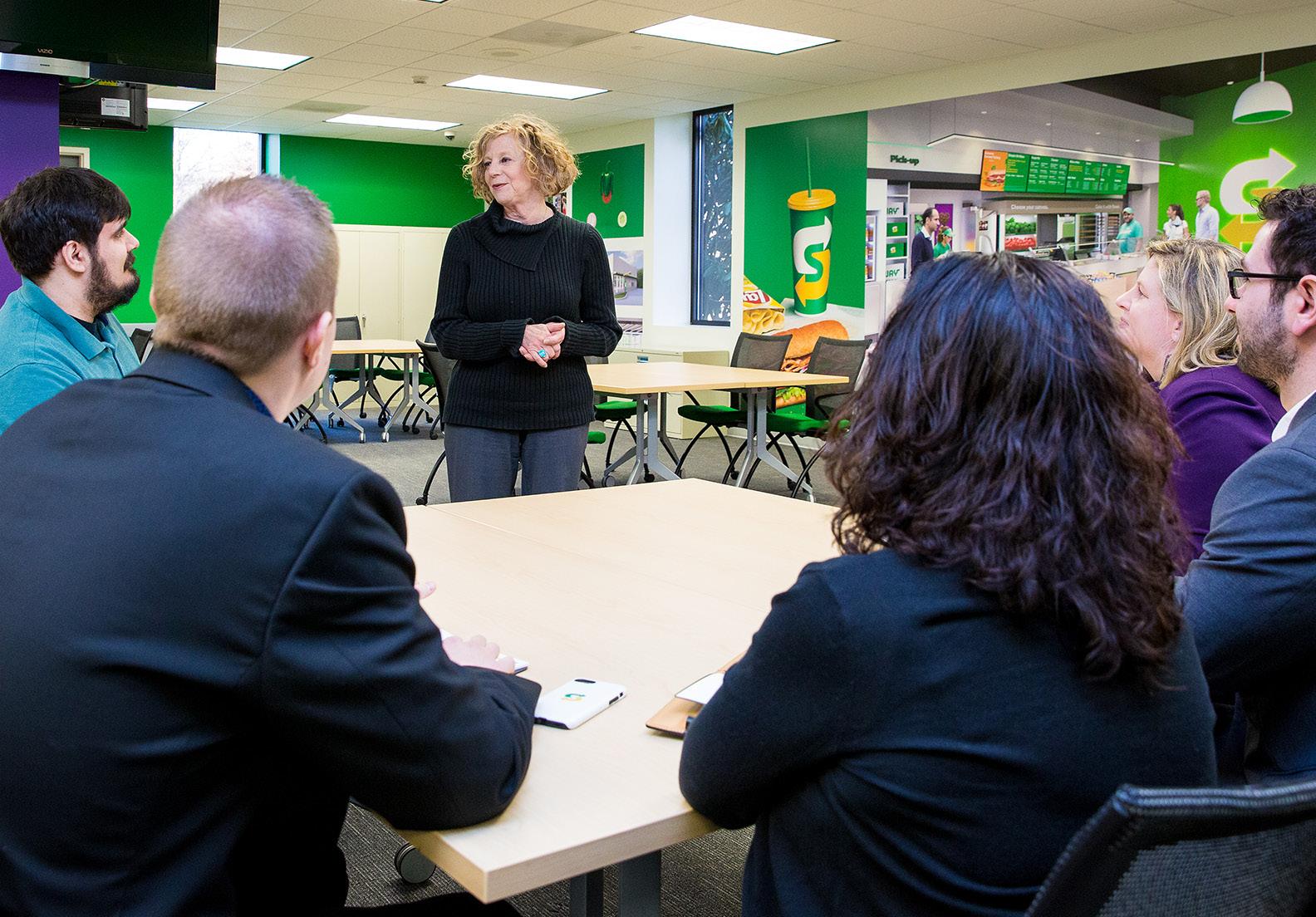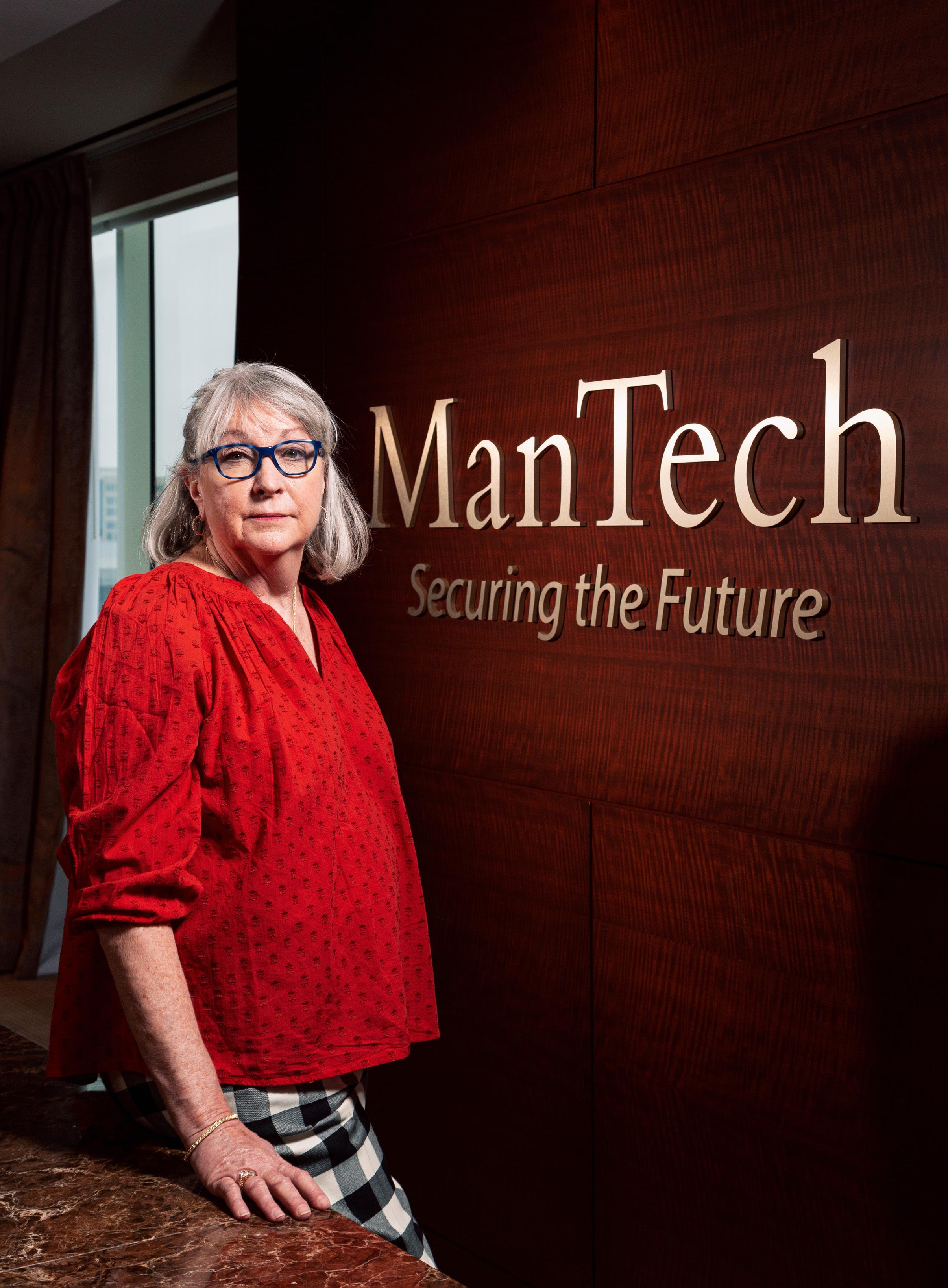
28 minute read
Change in the Era of Digital Transformation
Managing Change in the ra of
Digital Transformation
Advertisement
It’s time to stop hiding behind the notion that change is hard. While true, it won’t help organizations navigate an increasingly VUCA world. Here are some strategies for the new decade.
BY MARK MARONE
The new decade promises a whole new approach for the speed of change. VUCA — or volatile, uncertain, complex and ambiguous — has gone from military jargon to an overused business acronym. Organizations are recognizing the need to exist in a state of constant readiness to respond to new information about changing customer requirements, stakeholder expectations, regulation and competition. It’s a matter of survival. The life expectancy of public companies has plummeted. It’s estimated that nearly 1 in 10 public companies fail each year, a fourfold increase since 1965, according to the BCG Henderson Institute. Managing change more effectively has shot to the top of the priority list for many organizations, with 81 percent of respondents to the 2019 Deloitte “Global Human Capital Trends” survey saying the 21st century will require a special focus on “leading through complexity and ambiguity.”
The goals of change management — creating confident, positive and optimistic stakeholders with the skills and commitment to ensure new initiatives succeed — aren’t new. The need for effective change management isn’t new, either — humans have had to work together to adapt to changing conditions and circumstances for millennia.
What’s New in Change Management?
The simple answer to what’s new in change management is the context in which leaders must lead change. Once upon a time, “change” was something temporary in the workplace. Organizations toughened themselves to get through it and get back to normal. That time has passed. Today, change is the regular work, and with this shift came the concept of change fatigue.
At the same time, artificial intelligence is coming into its own. Its implementation across nearly every industry is bringing disruption and intense pressure to adapt for organizations and employees alike. The impact is predicted to be on a scale unlike anything seen before. According to research conducted in 2017 by PwC, global GDP could be up to 14 percent higher in 2030 as a result of AI — the equivalent of an additional $15.7 trillion. A 2019 survey of 5,376 full-time employees across 20 countries conducted by Dale Carnegie Training found that 72 percent say they are either already being impacted by AI in their roles or expect to be within the next five years.
Complicating the situation further, many in leadership positions are charged with managing teams made up not only of traditional full-time employees, but also contract or “gig” workers with whom leaders may not have long-standing, trusting relationships. In addition, some or all of those employees may also work remotely, making it more challenging to assess and address individual reactions and commitment to change.
And just when people who are innately adaptable are most needed to deal with this accelerated pace of change, the American workforce is getting older. The Bureau of Labor Statistics estimates that by 2024, nearly a quarter of the U.S. workforce will be 55 or older, with about a third of those workers older than 65. That’s bad news given that some research (but not all, it should be noted) suggests older workers can be more resistant to change. Lessons for Leaders
Given all of this, there is no doubt that learning and development professionals should have change management on their radar. As you assess your organization’s current change readiness, it’s essential to recognize that success today goes beyond leaders’ capacity to guide the implementation of formal change initiatives. It’s not about simply managing change anymore. It’s about leading teams to incubate, innovate, implement and propagate change. What is needed is leadership agility, which requires courage, a genuine openness to new information and learning, and a positive attitude toward change.
Yet even leaders in organizations that get traditional project-based change management right are finding it challenging to accept that change can — and should — come from new places (think frontline employees, customers, and through partnerships with vendors and even competitors). Unfortunately, it’s often senior leaders who are an organization’s own worst enemy when it comes to true transformational change.
Take the example of a large Midwestern bearing manufacturer faced with eroding market share for a $40 million business unit, its largest. The vice president in charge launched a project to drive manufacturing efficiencies using an AI-based system to identify and address key process bottlenecks in scheduling and inventory management.
He did everything right when it came to leading the change initiative: He shared the vision for the change outcome and built trust through a process of weekly and monthly communications and meetings. He involved the employees being impacted by the AI deployment from the beginning. He gave everyone a chance to ask questions and share ideas, and he reduced uncertainty by addressing concerns and being transparent throughout the process, providing training and upskilling in parallel with each step of the deployment and reassuring his people they wouldn’t be “left out in the cold.”
In the end, the project was acclaimed as a tremendous success. It improved overall service levels and ultimately resulted in a 15 percent growth rate while increasing earnings before interest and taxes by 18 percent.
But when asked about it, instead of being elated, the vice president admitted he was actually disappointed. He and his team were frustrated that despite senior management’s awareness and acknowledgment of the program’s success, none of the learnings and changes were shared with or adopted by other business units, resulting in what they saw as huge missed opportunities for similar AI-driven projects across the wider organization. For the vice president, it was a serious failure from that perspective. Today’s environment rewards leadership teams that are quick to identify and ready to embrace opportunities for transformational change.
His business unit had to change — the status quo (losing money and market share) wasn’t working. And they did change. But for organizations to survive and thrive today, they need forward-thinking leadership Psychological safety is among the most critical elements of a culture that supports team effectiveness and innovation.
Digital Natives Will Soon Be 20% of the Workforce Are you ready?
Help Digital Natives contribute more, faster, with learning paths designed speci cally for them .
What Is Digital Transformation, Really?
Digital transformation involves completely rethinking how an organization uses technology and how those technologies interact with processes and
people across every area of the business. While the concept may be clear enough, the path forward isn’t a straight shot, and it will be different for every organization.
Approaches vary. The speed of technological advances and resulting influence on customer
expectations is outpacing the rate at which many organizations are used to changing. That leaves some leadership teams feeling completely overwhelmed, especially in companies with change
averse cultures. Others are moving forward with limited, internal-facing projects and experiments to automate manual work in select areas of the business. A few are boldly developing comprehen
sive strategies and investing tremendous resources to try to jump ahead of the competition and preempt disruptors.
The essential challenge of digital transformation may be this: No one can predict the technological advances of tomorrow and their possible appli
cations. This is a race with no finish line, which is exactly why an organization needs agility from its leaders. Successful digital transformation will require a resilient corporate culture that embraces
change and learns from mistakes, listens closely to customers and employees for innovative ideas, collaborates effectively and implements learning quickly across the organization.
Digital transformation isn’t a sprint. It’s more like embarking on a neverending marathon.
that will act on opportunities for continuous improvement before they are forced to.
How to Boost Leadership Agility
What can CLOs and L&D professionals do to help boost leadership agility in their organizations? Consider these four strategies to strengthen leaders’ mindsets, skills and behaviors when it comes to change.
First, help leadership teams take an honest look at themselves. It’s not easy. People have different innate orientations toward change. Where are each of your organization’s leaders on the change acceptance continuum? What does that mean for the leadership team as a unit? Are some leaders behaving in ways that prevent successful change from happening or moving across the organization? When change initiatives fail, as they often do, is your leadership team still playing the blame game?
If there are issues, it’s imperative to understand why. Are they worried about losing influence? Uncomfortable with technology? Having a hard time handling the stress and worry that comes with change fatigue? There are strategies for dealing with all of these issues, but they require skilled communication to uncover root causes and a commitment of time and resources to mitigate them.
Second, develop leaders’ ability to create an environment of psychological safety that encourages learning and risk-taking. Research is pointing to psychological safety as among the most critical elements of a culture that supports team effectiveness and innovation. And since employees find themselves working on teams more than ever, that importance can’t be overemphasized. Companies are finding a competitive advantage in using new technologies to derive insights from the abundance of data now available — but the value lies in learning from the data and acting quickly in response to it.
Yet many of today’s leaders did not grow up in a business environment that encouraged psychological safety and risk-taking. No more than a few years ago, top-down objective-setting, management by exception and forced-distribution performance ratings were standard practice. They still are in many companies. And just as grown children typically adopt parenting techniques they learned in their own formative years, otherwise good leaders may not know how to create psychological safety without coaching. Learning leaders can help.
A third strategy is to assist leaders in skillfully communicating change and recognizing natural change advocates. It’s important to recognize that while people’s initial reaction to change varies, reaction is different from commitment. No matter what their initial reaction is, an individual’s commitment to change can be developed. It begins with skillful, transparent communication of the vision for the change in a way that connects it to the organization’s purpose, appeals to employees’ motives and makes the change objective clear.
For teams that include remote workers, the lack of face time can make it harder to identify those needing extra help getting through change. With fewer live opportunities to communicate with remote employees, leaders need to be especially skilled and deliberate.
It’s a leader’s responsibility to calm fears, address concerns and help each person see the importance of their role in the change and the personal benefit that will result. It requires the ability to see the change from others’
Robots aren’t coming to take your jobs
They’re already here
Our research shows that many CLOs and HR managers have put off planning for the changes AI & automation are bringing to their industries. But by planning, recruiting, and upskilling your workforce now, you can use these technological disruptions to change (or protect) where you stand among your competitors.
It’s not too late. Join Southern New Hampshire University and a panel of industry leaders to learn how to begin planning for the competitive and workforce challenges your organization is already facing.
AI & AUTOMATION PANEL DISCUSSION CLO Symposium, Bonita Springs, FL
Your Reality, Our Research, and a Path Forward Day 2 (April 7) | Room: Estero A | 2:45 – 3:45 PM
YOU’VE GOT TALENT BRING OUT THE BEST IN IT
Pete Martinez, Vice President of Talent Management at the Adecco Group. Pete is a recognized strategic leader for transforming business goals into learning results. He leads passionate teams to develop creative, engaging training that links daily practice to fantastic outcomes in leadership, sales, and operations.
“A key focus area for our company is keeping learners engaged beyond their first six months of training in the field. We want learning to become part of each colleague’s day, as natural as checking email. To do that, we needed to create brief and relevant training accessible by all colleagues.


We partnered with DeVry University to build a series of webinars, classroom training and a one-week blitz on topics that colleagues tell us they want to learn about to do their work more effectively. Several topics are delivered virtually or on-site by DeVry, which our learners find instrumental to their continued development.”
We’re proud that our education partnership has helped Pete’s work align with his strong empathy for learners at all levels.
THANK YOU, PETE. YOU TEACH US WAYS TO BUILD
PROGRESSIVE PATHS FOR EVERY COLLEAGUE YOU HIRE!

TALENT DEVELOPMENT • SKILLS GAP TRAINING • TALENT ACQUISITION
In New York, DeVry University operates as DeVry College of New York. DeVry University is accredited by The Higher Learning Commission (HLC), www.hlcommission.org. Keller Graduate School of Management is included in this accreditation. DeVry is certified to operate by the State Council of Higher Education for Virginia. Arlington Campus: 2450 Crystal Dr., Arlington, VA 22202. DeVry University is authorized for operation as a postsecondary educational institution by the Tennessee Higher Education Commission, www.tn.gov/thec. Nashville Campus: 3343 Perimeter Hill Dr., Nashville, TN 37211. Unresolved complaints may be reported to the Illinois Board of Higher Education through the online complaint system http://complaints.ibhe.org/ or by mail to 1 N. Old State Capitol Plaza, Ste. 333, Springfield, IL 62701-1377. Program, course and extended classroom availability vary by location. In site-based programs, students will be required to take a substantial amount of coursework online to complete their program. ©2020 DeVry Educational Development Corp. All rights reserved. 3/20
Congratulations to our DeVryWORKS 2020 TEACH Award winners. We can all learn from leaders like these!
Teamwork • Energy • Accountability • Community • HEArT
Cathy Konnik, Global Director of Learning & Development at Subway. Cathy leads the way in providing development opportunities to the organization’s field audience, hired and maintained by franchise owners and contracted executives. She focuses her team on modern learning methods that lend themselves to technology-based implementation.
“We provide convenient, easy access to proper training— and we’ve learned that restaurants using our strong training tool demonstrate better performance on KPIs important to the business. Also, on day one, all team members gain access to tuition savings at six accredited online universities, including DeVry.


This benefit enables our franchise owners to recruit and retain top talent…starting with those serving our guests every day. DeVry’s presence at our college fairs and events helps deliver the message that the organization cares about human capital and talent development.”

THANK YOU, CATHY. YOU TEACH US MUCH ABOUT THE STRATEGIC
VALUE OF HUMAN DEVELOPMENT!
We’re proud that our education partnership has helped Cathy’s work promote a culture of care that supports team members who pursue a college education as working adults.
devryworks.com 866.606.8349
W
The tech behind LXP de-mystified
Most people are familiar with a learning management system (LMS). But the emergence of the learning experience platform (LXP) has brought a variety of new enabling technologies which might be less familiar to the average learning professional.
For most of us, the important thing about any technology is not so much what it is as what you can do with it. If you belong to one of the 50% of companies who research tells us are likely to buy an LXP in the next 24 months, 1 it helps to know something about these underpinning technologies. This glossary is intended to speed your learning about the technologies behind LXP.
Glossary
Content Management System (CMS) A CMS supports the organization, modification, and presentation of digital information. At the heart of almost all learning systems is content management technology. However, the classic LMS was designed to handle a very limited range of content types.
As bandwidth and computing power have increased over time, animations, video, games, and other content types moved into mainstream use for learning, and the LMS has struggled to keep up. As such, many people built learning portals (content managed websites) to supplement or front-end their LMS. same time, we typically adjust our expectations downward when it comes to using a search engine on corporate applications and systems. Broadly speaking, search on many such systems has historically been of a much simpler type, designed to deal with structured data (i.e. information organized in a database) or to pick out particular words and phrases. This might be adequate for an LMS running solely e-learning modules and PDF documents. However, in a more diverse content environment where a fair amount of the data is unstructured, it’s unlikely to return particularly relevant results. This leads to valuable learning resources being at risk to be excluded from the search results. The LXP brings onboard search up to the current state of the art, with AI-driven technology using natural language processing (NLP) that returns relevant, actionable results.
User-Generated Content (UGC) In this context, UGC refers to the content on a system placed there by learners themselves. UGC can include discussion threads, star ratings, image sharing, user-made videos, and a wide range of learner contributions.
Another important aspect of UGC is the ability to transfer valuable knowledge within the organization. A modern LXP should include the required technology to support UGC.
The content management capabilities of an LXP start from a place of CMS power and sophistication. It assumes both a wide variety of content types and the ability of learners to generate and upload their own content to the system. Search We’re all familiar with internet searching, and almost take for granted the AI and natural language processing (NLP) that goes into delivering quick, relevant research results. At the Application Programming Interface (API) An API allows an application to use the data or functionality of another application without getting into the wiring of how that other application works. We use APIs all the time — often without knowing it. In the case of an LXP, APIs might be used to draw in data about courses on a third-party system. Additionally, APIs give learners access to the functionality of a curation app without ever leaving the LXP. 1 McElvaney, P. New research points to a billion-dollar market for LXP. Learning Pool.
Experience API (xAPI) A specialized API created specifically for learning systems, xAPI makes it possible to record data about a wide range of learning experiences, both offline and online. It also allows this learning data to be collated with business data from other corporate systems. Since the LXP is fundamentally about the learner experience, being able to accurately record and track those interactions is necessary in the platform.
Learning Record Store (LRS) The principal function of an LRS is to store xAPI statements from a variety of platforms within an organization’s ecosystem. An LRS typically sits outside of the LMS or LXP and becomes the central source of truth.
The LRS also allows in-depth learning analytics since xAPI allows the recording of many data points. Coupled with the ability to correlate with the other sources of data within an ecosystem, L&D teams will have more insight into their learners and the effectiveness of their programs.

Artificial Intelligence (AI) In this context, the two main uses of AI within LXPs are providing personalized recommendations and conversational bots (virtual assistants).
We are all familiar with AI-driven recommendations in our lives as consumers. In the case of learning, learners can record their preferences for what they want to learn on the LXP. The system can also make inferences based on their platform behavior and recommend relevant follow-on learning, experiences, or resources to complement their current learning. Bots appear on many websites to help us navigate to what we need via text chat. Bots make use of natural language processing (NLP) to draw inferences and return relevant suggestions about what we’re trying to achieve. Bots help and support learners by answering queries and signposting the resources and experiences they need. The primary aim is to take friction out of the learning process, making it more accessible and attractive to learners. For more information and to download the white paper Powering the Modern Learner Experience: Next-Generation Learning Tools Come of Age, visit learningpool.com.
The Wolf of Warfare
Karen Wolf, chief learning officer at ManTech International, keeps her workforce on the cutting edge of new technologies and digital transformation.
BY ASHLEY ST. JOHN
The path to chief learning officer is often an unconventional one. Karen Wolf’s journey is especially compelling.
“I came to learning and development in a very odd career progression. I spent 25 years as a special agent in the FBI,” said Wolf, CLO at ManTech International. “My background was in drug-related public corruption investigations — think dirty police officers stealing drugs and selling them on the street.”
In her current role, however, she’s no longer taking down crooked cops. At ManTech, an American defense contracting firm specializing in cybersecurity and IT, Wolf is responsible for the development of more than 9,000 employees who are passionate about protecting national security. The government contractor offers services in the defense, intelligence and federal civilian markets.
“For us, learning and development is not a benefit,” Wolf said. “It’s not something we offer to our employees like dental insurance. We don’t stay in business without our employees being on the cutting edge of new technologies and digital transformation, because that’s the services that we provide to the government — whatever the latest and greatest cutting-edge stuff is.”
Wolf’s position comes with its share of challenges. She heads an L&D team of only five, responsible for the development of a geographically dispersed workforce with at least 80 percent of employees working offsite. But her unique background prepared her for the role.
Becoming a Role Model
In 1982, after getting her bachelor’s degree in communications and a stint with a public relations firm, Wolf enrolled in the FBI Academy in Quantico, Virginia. She graduated in 1983 and began her career in law enforcement as a firearms instructor for the bureau.
“I had some big cases in the FBI that I was very proud of, that a ton of work went into — multiyearlong undercover investigations,” Wolf said. “I helped put a former governor in jail for corruption in Louisiana. I worked some star-stalker cases when I was in Los Angeles.”
Wolf was one of the first 100 women hired by the FBI. In her first two field offices, she was the only female agent at times. This made it difficult to find female role models, which in part prompted Wolf’s next move.
“I really wanted to get back to the FBI Academy because when I went through the academy, there were no women on the faculty,” she said. “I think it really does help for women and people of color and minorities to have someone to look up to.”
“There’s nothing that makes a law enforcement officer more uncomfortable than not being in command of a great skill set.” — Karen Wolf, chief learning officer, ManTech International
Wolf ended up back at Quantico teaching in-classroom instruction in specialized areas of FBI investigations. But once she began teaching adults, she realized she didn’t really know what she was doing.
“There’s nothing that makes a law enforcement officer more uncomfortable than not being in command of a great skill set,” she said. “So, going back to school made a ton of sense.”
At the age of 45, Wolf enrolled at the University of Virginia and earned her master’s degree in education, followed by her doctorate in educational leadership. The FBI paid for her degrees and then pushed her to move up the administrative ranks at the FBI Academy.
“They had somebody who now could wear both hats — being sworn law enforcement and also having gotten those degrees,” Wolf said.
In 2006, Wolf retired from the FBI and went to

work in the intelligence community doing instructional design and teaching as a subject matter expert. Then in 2010, a stroke of luck brought her to ManTech.
“I’d worked for Al Malinchak when he was in the FBI — he was my boss at the FBI Academy, and he retired and I took over his job,” she said. Malinchak then became CLO of ManTech. “I called him for a reference, and he said, ‘Heck, I’ve got a job open. Would you work for me again?’ He was a great boss, so that was kind of a no-brainer.”
A Unique Set of Challenges
When Malinchak left ManTech in 2011, Wolf once again took over his role, this time as CLO. Working with a small department, it’s a big job. And it comes with a lot of challenges, one being a workforce dispersed across 46 U.S. states and 40 countries.
“At least 80 percent of our employees actually work at a customer site,” Wolf explained. “So, they’re on customer systems all day long, they’re performing the customers’ mission. They’re not necessarily in ManTech email. They’re not necessarily on ManTech systems. It’s not like I’ve got a captive audience that’s easy to reach out and touch.”
Due to the nature of their work, ManTech’s workforce also has a broad skill set, and offering a wide range of training is another challenge for Wolf.
“We have some folks who are in Afghanistan, who are providing support to the warfighter and who do very specific and technical work. They keep pieces of machinery running, they deploy mobile cell phone towers. So their training needs are different from somebody who is a data wrangler on a contract for the Department of Homeland Security,” Wolf said.
Despite these challenges, Wolf said she feels fortunate to have clarity in her mission, thanks to ManTech CEO Kevin Phillips’ 2020 strategic plan. The plan outlines ManTech’s top initiative: to be an employer of choice.
“In our industry, the way you become an employer of choice is to have learning and development opportunities that are far different from our competition and from what you see typically in the industry,” Wolf said. career enablement through a partnership with Purdue Global University. The alliance stemmed from a problem that was addressed two years ago — the struggle of getting ManTech employees to pass the Certified Information Systems Security Professional training. The certification is often listed as a requirement on government contracts. It’s a difficult exam requiring people to develop a broad knowledge base across 12 areas, and ManTech’s existing weeklong bootcamp to prepare employees wasn’t cutting it.
At the time, ManTech was in conversation with a new university alliance partner called Kaplan Education, which has since become Purdue Global University. One of the things they offered was college courses that tracked to the certification. And once you have the certification, you also get credit for the courses.
“We were able to start putting employees through those cohorts to get the certifications [through] a much longer treatment of the material, much more academic, lots more practice,” Wolf said. “And we realized that people were passing the exam at a better rate.”
From that partnership, they then started talking about degrees that would suit the ManTech workforce. Purdue Global offered two degrees that were very popular among employees: a bachelor’s and a master’s in IT, and a bachelor’s and a master’s in cybersecurity. Wolf also identified a need for a degree in cloud computing and solutions, so their subject matter experts teamed with the academic faculty at Purdue Global to jointly develop that degree. In 2019, they also developed a degree in data analytics.
According to Wolf, employees love the program. They recently had a graduation and cake ceremony for their first 18 graduates.
“Sixteen of them have master’s degrees, and two actually did their bachelor’s degree in about a year and a half. One of the reasons they could do a four-year bachelor’s degree in such a short period of time is many of them

Solutions That Stand Out
One of the ways ManTech is setting itself apart is by pivoting from a culture of performance appraisal to one of career enablement, moving away from numeric ratings into a system of quarterly check-in conversations between managers and employees.
They are also moving the needle on
Powering Education as a Business Strategy

BUILD A FUTURE-READY WORKFORCE TODAY
Education is no longer just an employee benefit. It is a forward-thinking employer strategy to fill specific skills gaps, recruit and retain the best talent, and improve organizational performance.
With more than 80 years of experience in higher education and over 10,000 business clients, Kaplan is a leader in providing customized education solutions to meet the workforce development needs of organizations worldwide.
Start the conversation today about your business needs and challenges. Contact our dedicated team at StrategicPartnerships@Kaplan.com.
had those certifications, and with those certifications comes the articulated credit for those classes,” she said.
Currently, almost 5 percent of their workforce is involved in taking college degrees, with the goal of increasing that number to 10 percent in 2020.
Stephanie Flory, ManTech’s workforce development and technical training manager, attests to the program’s success.
“I used to run our career mobility program, and when we built our partnership with Purdue Global, that was a direct linkage to our folks who were seeking new opportunities in the company,” Flory said. “And that just blew up. It got so big and we had so much interest that I started doing more and more with ManTech U and ended up leaving my role to work full time under Karen.”
Another partnership, with Skillsoft, has been very positive. According to Wolf, Skillsoft offers training that appeals to a broad variety of job families and types of work that ManTech does. They also launched a program in 2019 called Aspire Journey, which consists of pre-curated content that is sequenced in beginning, intermediate and expert, with users acquiring badges and doing assessments along the way.
“It’s been wildly popular with our employees because many of those Aspire Journeys mirror the developing skill sets that we need to support digital transformation,” Wolf said. “They have an Aspire Journey on machine learning, on artificial intelligence, on becoming a Pythonista. Those are the types of skill sets that our employees are interested in.”
The partnership also has allowed ManTech to democratize training across the company, Wolf said. In the past, profit or overhead dollars on a contract were used to fund any necessary training. But they didn’t always have that overhead, so it was uneven in terms of who in the company got the training. Now the costs are not allocated back to the contractor — they’re held at the corporate level — so anybody can take anything that they’re interested in, even if it’s not related to their contract.
“It’s changed how people view learning and development,” Wolf said. “It’s put it in the hands of our employees, so they can take ownership of their career. And our use rate and our adoption rate is through the roof — we’re well into a 60 percent user rate.”
Wolf was initially surprised to learn that use is highest on Saturday mornings.
“It’s people who probably have kids running around at soccer practice, and they’re taking a course on their mobile device,” she said. “They’re doing it on their own time, which tells me that they really value the content.”
Helping People Be Their Best
Among her colleagues, Wolf is respected as a strong and direct leader. And she’s got her own unique leadership style.
Wolf has put learning into the hands of ManTech employees.

“She’s very direct, very clear, and there’s no guesswork with her, which is refreshing for me,” Flory said. “She’s one of the most communicative bosses I’ve ever had.”
She also believes heavily in servant leadership, Flory said: “She will take out the trash, … fix a projector in one of the classrooms, and then go sit in a strategy session or go meet with the CEO and make magic happen.”
Jeff Brody, ManTech’s CHRO, is impressed with the way Wolf ties her efforts back to the success of the business: “She is the consummate lightning rod for why development is important, and not just for the sake of developing, but really translating that into business outcomes.”
There are exciting developments on the horizon for Wolf. Her team is currently working on an advanced cybertraining program to develop a specific set of skills for people in cybercommand. And they have partnered with a magnet school in Loudoun County, Virginia, to bring on interns to perform work for customers in the intelligence community through interim clearances, an initiative that Wolf said positions ManTech as an employer of choice for those entering the workforce.
It’s not just her enthusiasm that allows Wolf to be effective in her role.
“She has this incredible background,” Flory said. “It gives her breadth and depth in the field of learning and development.”
Wolf’s career may have been somewhat unconventional, but it has allowed her to see different sides to people and situations, something she said drives her.
“I spent a career in law enforcement, where a lot of times I saw people at their worst,” Wolf said. “This is different for me and it gets me out of bed because I get to see people doing their best.” CLO













